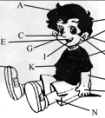根据句意和首字母提示每空填一个单词,使句意完整。 1. This is my s________ Ann. 2. What's that in E________? 3. A________ these your brothers? 4. Jack h___-七年级英语
| 规则 | 动词原形 | 第三人称 单数形式 | |
| s | 一般在词尾加s(读音规则: 清清浊浊元浊, 在清辅音后读清辅音/s/, 在浊辅音和元音后读/z/) |
stop take clean play grow |
stops/s/ takes/s/ cleans/z/ plays/z/ grows/z/ |
| es | 以,x,ch,sh,或o结尾的动词 加-es(读/iz/) |
pass fix wash watch do |
passes fixes washes watches does |
| ies | 以辅音字母 加y结尾的动词,变y为ies(读/iz/) |
fly carry hurry |
flies carries hurries |
注意:不规则变化的有have—has, be—is, go—goes, do—does
一般现在时,当主语是第三人称单数时,谓语动词要用第三人称单数形式
主语是第三人称单数有以下几种情况:
(1) 不可数名词做主语:
Some water is in the glass
(2) 单个的可数名词做主语:
The girl is Chinese. My watch is on the dresser.
(3) He ,she , it 等代词单个做主语:
He is in the tree. She likes her family very much.
(4) 单个的人名,地名或称呼作主语:
Mary is a doctor. Uncle Li speaks a little English.
Changchun is a beautiful city.
(5) 指示代词this, that 等作主语:
This is a pear. That is an apple .
(6) Everyone, everything ,something, nobody, nothing.等不定代词作主语时
Is everyone here today? Everything is ok .
(7)单个数字作主语时:
”8” is a good number in China.
动词单数第三人称形式的一般现在时的句子的否定句、疑问句及特殊疑问句。 <?xml:namespace prefix = "o" ns = "urn:schemas-microsoft-com:office:office" />
否定句:
在主语的后面实义动词前加doesn’t(注意实义动词应恢复原形。)
主语(单三)+doesn’ + 动词原形+其他
Jim likes football变否定: Jim doesn’t like football
He has lunch at school. 变否定:He doesn’t have lunch at school.
一般疑问句及答语,在句子前面加助动词does. 实义动词恢复原形
Does +主语(单三)+ 动词原形+其他
Does your father work ? Yes, he does. /No, he doesn’t
特殊疑问句:特殊疑问词+一般疑问句
特殊疑问词+ does +主语(单三)+ 动词原形+其他
Where does a bird live ?
How does she go to school?
考点名称:动名词
- 动名词:
如果一个动词加上了ing变成了名词,那么这个词称动名词。 动名词是一种兼有动词和名词特征的非限定动词。
它可以支配宾语,也能被副词修饰。
由于动名词是由动词变化而来,它仍保留着动词的某些特征,具有动词的某些变化形式,用以表达名词所不能表达的较为复杂的意念。
动名词的名词特征表现在它可在句子中当名词来用,作主语、宾语、表语、定语。 动名词的结构和形式:
动名词的否定结构:
动名词的否定结构由not 动名词组成。如:
Trying without success is better than not trying at all. 实验没有成功也比不实验好。
He hated himself for not having work hard. 他悔恨自己没有用功。
I’m sorry for not having telephoned you before. 很抱歉,没有早给你打电话。
He felt sorry for not having done the work well. 他为没有把工作做好感到难过。
I fancy it has done you a lot of good not going. 我看不去对你倒好了。
(not going 是动名词一般式的否定形式)
There is no denying the fact that he si diligent.
(no denying 也是动名词一般式的否定)动名词复合结构:
通常情况下,动名词的逻辑主语为谓语动词的主语。如果动名词动作的发出者不失谓语动的主语时,则需要有自己的逻辑主语物主代词或名词所有格加动名词就构成了动名词的复合结构,这种结构在句中可以作主语,宾语等。
(1)逻辑主语是有生命的名词作主语时,必须用名词或代词所有格,作宾语时(尤其在口语中),也可用名词普通个或人称代词宾格。如:
Do you think my going there will be of any help?
你看我去会有什么帮助吗?(宾语)
The student’s knowing English well helps him in learning French.
这位学生通晓英语对他学法语很有帮助。(主语)
Do you mind my(me) smoking ? 你介意我抽烟吗?(宾语)
They insist on Mary’s (Mary) going with them there.
他们坚持要玛丽跟他们一起去那儿。(介词宾语)
(2)逻辑主语是无生命名词是,通常只用名词普通格。如:
Do you hear the rain pattering on the roof?
你听见雨点打在屋顶上了吗?
Is there any hope of our team winning the match ?
我们对赢得比赛有希望吗?
(3) 逻辑主语是指示代词或不定代词this that , somebody , someone , nobody, none, anybody, anyone 时,只用普通格。如:
She was woken up by somebody shouting outside.
她被外面喊叫的人吵醒了。动名词的形式(一般式,完成式和被动式):
(1) 动名词的一般式所表示的动作与谓语动词所表示的动作同时发生,或在谓语动词表示的动作之后。如:
- 最新内容
- 相关内容
- 网友推荐
- 图文推荐
| [家长教育] 孩子为什么会和父母感情疏离? (2019-07-14) |
| [教师分享] 给远方姐姐的一封信 (2018-11-07) |
| [教师分享] 伸缩门 (2018-11-07) |
| [教师分享] 回家乡 (2018-11-07) |
| [教师分享] 是风味也是人间 (2018-11-07) |
| [教师分享] 一句格言的启示 (2018-11-07) |
| [教师分享] 无规矩不成方圆 (2018-11-07) |
| [教师分享] 第十届全国教育名家论坛有感(二) (2018-11-07) |
| [教师分享] 贪玩的小狗 (2018-11-07) |
| [教师分享] 未命名文章 (2018-11-07) |






